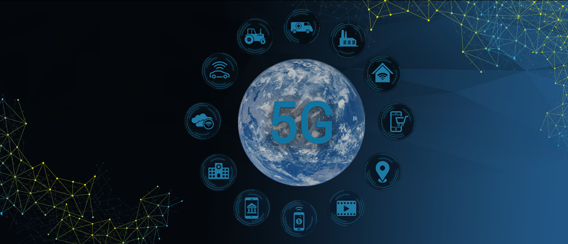5G future: Our world in 2025
5G… A catalyst for change, which will impact the mobile/telecoms industry and our world in general. The relevance of 5G to a variety of sectors—such as manufacturing, media and entertainment, health, automotive, transport, logistics or utilities—is anticipated to enhance the way we work and live. For many, 5G will accelerate the emergence of the “smart world”: smart cities, smart buildings, smart appliances, smart everything…
How much of that will have happened by 2025, following also the 5G standalone (SA) launch and the advent of end-to-end network slicing? Wild guesses aside, let’s discuss what we realistically expect to see.
5G, five years from now*
Which 5G use cases are likely to change our world by 2025? Well, what about virtual reality (VR) and augmented reality (AR)? These should transform how we watch sports (including our live stadium experience), travel (e.g., visit historical sites), shop, learn, etc. To a varying extent, the 5G promise of a new “extended” reality should be more than just a promise five years from now.
A similar point holds true about the rise of robots, particularly in applications pertinent to the latest industrial revolution denoted as Industry 4.0. By 2025, we are likely to see robots elsewhere too, from parking valets to home companions to delivery drones. On the other hand, many exciting 5G use cases may just about start changing our world. Think of the internet of senses—not limited to tactile internet—for example.
Challenges of 5G: network domains, concepts, infrastructure…*
The impact of 5G use cases depends on overcoming a number of challenges. The usual network/service launch challenge applies to 5G too: the need to “get it right, the first time.” Importantly, any 5G non-standalone (NSA) performance issues will affect not just the success of 5G NSA, but the overall success of 5G. The detrimental effect of negative publicity, including social media “word of mouth,” should not be underestimated.
On a high level, the discussion on 5G challenges typically revolves around three areas: complexity, investment, and regulation. Complexity in particular is a huge concern, especially as 5G builds upon distinct but inextricably linked foundational blocks: new 5G features, 4G (for NSA), new concepts (mainly from IT) and the underlying fiber infrastructure. Similarly, 5G network slicing mandates optimal domain-specific and end-to-end (device to external servers) performance.
Aiming for 5G success by 2025*
What do we need to ensure that 5G fully delivers by 2025? To begin with, we should not overlook the “basics” or high-level network lifecycle approach: verify features/capabilities and relevant equipment/software as early as possible; deploy infrastructure and services based on ROI-driven planning and comprehensive testing; operate network and services focusing on user/device experience and monetization criteria.
In effect, 5G’s complexity exacerbates challenges related to testing (in the lab or in the field), monitoring, assurance, etc. In the light of 5G’s complexity, investment and regulation landscape, the success of 5G hinges on three interrelated themes:
- Automation, for simpler tasks as well as more intricate or ad-hoc activities (e.g., orchestration)
- Intelligence, including the “right” data and insights as well as AI
- Mindset, as required by the B2B/B2B2C nature of 5G and by the fading demarcation line between telecoms and IT
To find out more, read the EXFO white paper “Our 5G world in 2025: what to expect, how to make it happen” or watch the recorded EXFO and RCR Wireless webinar of the same title. For further details on addressing the 5G challenges—e.g., in 5G testing and 5G monitoring—please check the relevant webpages or contact EXFO.
* Note: This section is only a “glimpse” (subset) of the content presented in a recent EXFO and RCR Wireless webinar and included in a recently published EXFO white paper, both entitled “Our 5G world in 2025: what to expect, how to make it happen”.




